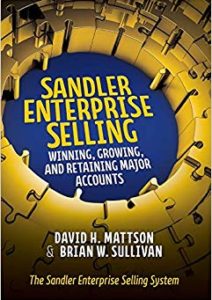I taught a Selling class at Loyola University Maryland and many of the students were shocked when they saw the syllabus, which indicated that participation was 50% of their grade. I always promised my students that I would focus on what was truly important in the real world of selling, not what was chronicled in textbooks and articles. And active participation in the real world of selling, of course, is worth much more than 50% of the grade. Surprising the students further was the fact that attendance was mandatory. For how can you actively participate if you don’t bother to show up? As such, my syllabus was a lesson in itself.
Holding on to the thought that attendance is a prerequisite to participation, I’d like to talk about everybody’s favorite selling topic – account growth. Expanding major accounts is the goal of selling teams everywhere – bloom where you’re planted! Much less focus is given, though, to the seemingly less sexy topic of account retention. It’s almost as if retention is a passive function as opposed to the mightily active growth activity. Of course, nothing could be further from the truth. Remembering that “prerequisite” word, how can you grow something that you haven’t retained? Indeed.
Of course, most organizations gain roughly 80% of their revenues from 20% of their clients. And winning new major accounts costs up to 20 times more than keeping current ones. Regarding that “keeping”, even a small increase in a firm’s client retention rate exponentially accelerates revenues and profits. On the flip side, though, decreases in client retention rates produce negative impacts that can be devastating. The trauma following the announcement about a major client leaving is unfortunately familiar to most of us who have made careers in selling. Given the crushing impacts of these losses, you’d think all selling organizations would focus intensely on retaining these valuable assets.
But most selling organizations aren’t built for account retention. Strategizing how to keep large clients is seen as a long-term initiative while the short-term focus is chasing the numbers – “What have you sold today?”. CRM systems with their opportunities and probabilities feeding forecasts and budgets have little connection to retention, per se. Selling organizations are structured to take advantage of opportunities and to fix client problems quickly. Of course, reacting swiftly is important to clients. But major accounts are ecosystems demanding much more than fast action. Understanding clearly what matters most to each major account is vital. And applying that knowledge to the critical factors that impact retention earns you a much better chance of keeping your customers long-term.
But how do you implement an account retention framework and then realistically integrate it into your “What have you sold today?” model? If it doesn’t align with the everyday touchpoints your team has with major accounts, it’s worthless. It may as well be integrated uselessly into the annual account planning exercise and returned to the shelf until the following year. For something as critical as major account retention, you must do better.
The framework must be built on the fundamental reasons why major accounts stay or go. Consider these 16 “stay or go” reasons – the “Critical Retention Factors”:
- Delivering True Value
- Communicating Freely with the Account
- Effectively Covering the Buyer Network
- Nurturing C-Level Executive Relationships
- Being Truly Relevant – Going Deep and Wide
- Delivering a Variety of Products/Services
- Achieving Your Wallet Share of Winnable Business
- Holding Long-Term Contracts
- Working Active Pipeline Account Opportunities
- Forecasting Account Revenue Growth
- Achieving Healthy Account Margins
- Successfully Delivering
- Understanding the Account and Industry
- Achieving Positive Client Satisfaction
- Nurturing High Trust Levels
- Achieving the Account’s Dependence
Think about it. If you’re not dynamically tracking your performance with major accounts, gathering intelligence to serve more effectively, you are vulnerable. Your very continuation is in jeopardy. Sophisticated competitors are constantly developing strategies to exploit your weaknesses and steal your major accounts. And don’t kid yourself – they know who your clients are and they’re coming for them. So, in retaining major accounts, there’s no standing still, only action to be taken.
How do you begin? You organize your organization’s account team – sales, delivery and other key personnel touching the account to develop candid evaluations of your performance in each of the critical retention factors. Not what you hope your performance will be but what it actually is. In true team selling fashion, your team’s collaboration insures that these sessions make a difference.
But while there’s value in these evaluations, the primary focus must be on action. In account retention, the real magic is in identifying what to do to improve your position in each critical retention factor, enhancing your account relationships. And with each improvement action, the team identifies the accountable individual and the realistic completion date. RACI is a powerful tool that can help.
Effectively deploying a practical account retention process is a survival skill for enterprise account teams – a workable framework aligned to your selling and service models. And it must be based on the customized reasons why a specific account will want to partner with you forever. When that is clearly understood, you’ve earned the right to make it happen. Without that understanding, you are flying blind.
So, forget your grammar lessons. In terms of major accounts, retention is not a noun, it’s a verb. It’s not what you get. It’s what you do.














































Comments